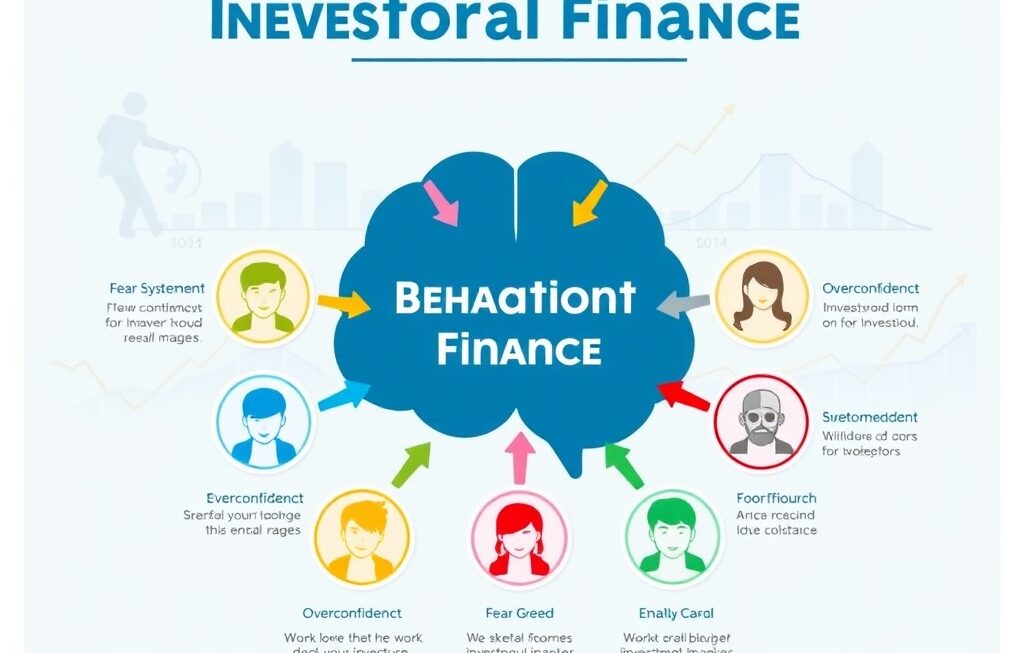How Emotions Impact Financial Decisions
Investing is often described as a rational process based on data, analysis, and logic. Yet, when we look at real-world behavior, it becomes clear that human psychology plays a crucial role in shaping financial decisions. The psychology of investing is what often separates successful investors from those who make costly mistakes. Understanding how emotions influence our actions in the markets is the foundation of becoming a smarter, more disciplined investor.
In today’s fast-paced financial world—where news spreads instantly and market movements trigger emotional reactions—it’s more important than ever to master not just the numbers, but also the mind behind them. This article explores how cognitive biases, emotional responses, and psychological traps shape investment choices, and how awareness can lead to better long-term outcomes.
Understanding the Psychology of Investing
The psychology of investing is the study of how cognitive and emotional factors affect investors’ behavior and decision-making. Traditional finance assumes that investors act rationally, always seeking to maximize returns and minimize risks. However, behavioral finance—a field pioneered by researchers like Daniel Kahneman and Amos Tversky—reveals that investors are not always rational.
Instead, people are influenced by emotions such as fear, greed, regret, and overconfidence. These emotions drive market bubbles, crashes, and irrational decisions that defy economic logic. The stock market, in many ways, is a reflection of collective human psychology at scale.
The Role of Emotions in Financial Decision-Making
Investing is inherently emotional because money represents more than numbers—it symbolizes security, success, and self-worth.
When market volatility strikes, fear and anxiety can cloud judgment, leading investors to sell at the wrong time. Conversely, excitement and greed can drive risky decisions during market booms.
Let’s break down the most common emotional forces influencing investors:
- Fear and Panic
Fear is one of the strongest emotional drivers in investing. When markets fall, fear of loss can cause investors to panic-sell, locking in losses instead of waiting for recovery. This phenomenon was evident during major market crashes like the 2008 financial crisis and the COVID-19 sell-off in 2020. Investors often prioritize avoiding loss over achieving gain—a concept known as loss aversion. Psychologists have found that losing money feels twice as painful as the pleasure of gaining the same amount. This explains why many investors exit markets prematurely during downturns.- Greed and Overconfidence
Greed can be just as dangerous as fear. In bullish markets, when prices keep rising, investors may believe that growth will continue indefinitely. Overconfidence leads to excessive risk-taking, ignoring fundamentals, and following speculative trends. This emotional high often fuels asset bubbles—periods when market prices become detached from reality. History offers many examples, from the dot-com bubble to the cryptocurrency boom. Eventually, markets correct, and emotional investors face sharp losses.- Regret and FOMO (Fear of Missing Out)
Many investors regret missed opportunities—like not buying a stock that later skyrockets. This regret leads to FOMO, pushing investors to jump into overheated markets too late. Instead of making strategic choices, they chase trends driven by emotion rather than analysis. The cycle of regret often results in a “buy high, sell low” pattern—one of the most common mistakes among retail investors.- Herd Mentality
Humans are social creatures, and in uncertain environments, we tend to follow the crowd. This herd behavior in investing causes people to buy or sell simply because others are doing the same. During market bubbles or panics, herd behavior amplifies volatility. Understanding this instinct—and resisting it—is key to successful investing.- Confirmation Bias
Investors often seek information that confirms their existing beliefs while ignoring evidence that contradicts them. This is known as confirmation bias. For example, a person convinced that a company will perform well may overlook warning signs or negative reports. Recognizing and questioning personal biases can help investors make more balanced, evidence-based decisions.
Cognitive Biases That Affect Investment Decisions
Beyond emotions, the human brain relies on mental shortcuts—called heuristics—that can distort judgment. In investing, these cognitive biases often lead to irrational decisions. Here are some of the most common ones:
- Anchoring Bias
Investors tend to fixate on a particular price point—such as the original purchase price of a stock—and use it as a reference for future decisions. This can prevent rational decision-making, especially when market conditions change. - Recency Bias
People give more weight to recent events than long-term trends. For instance, after a market crash, investors may assume that prices will continue falling, even when data suggests recovery. - Hindsight Bias
After a market event, investors often believe they “knew it all along.” This illusion of predictability can foster overconfidence and risky behavior in the future. - Disposition Effect
Many investors hold onto losing investments for too long, hoping to “get even,” while selling winners too early. This emotional attachment to losses often undermines portfolio performance. - Status Quo Bias
Some investors resist change, preferring to keep their portfolios static even when conditions demand adjustment. This conservatism can cause missed opportunities and slow portfolio growth.
How Market Sentiment Shapes Investment Behavior
Market sentiment—the collective mood of investors—often drives price movements more than fundamentals do. When optimism prevails, markets rise; when fear spreads, they fall.
The rise of social media and online investing platforms has amplified this dynamic. News, rumors, and viral posts can trigger massive buying or selling waves within hours. Emotional contagion spreads quickly in digital communities, influencing decisions even among experienced investors.
In 2025, tools like sentiment analysis and AI-driven trading models are helping investors measure and respond to market mood more effectively. However, the key remains the same: emotional awareness and discipline.
Developing Emotional Intelligence in Investing
Mastering the psychology of investing means developing emotional intelligence—understanding and managing your reactions under pressure. Here are strategies that help investors stay rational in emotional markets:
- Create a Long-Term Plan
A well-defined investment plan with clear goals, time horizons, and risk tolerance acts as an emotional anchor. When markets fluctuate, the plan reminds you to stay focused on long-term objectives instead of short-term noise. - Diversify Your Portfolio
Diversification reduces emotional stress by spreading risk across asset classes. When one investment underperforms, others can balance it out, helping maintain perspective during volatility. - Automate Your Investments
Automation removes emotion from the equation. Regular, automated contributions to a diversified portfolio (such as through dollar-cost averaging) help avoid impulsive decisions driven by market swings. - Practice Mindfulness and Patience
Emotional self-awareness is a powerful investment skill. Techniques like mindfulness, journaling, or meditation can help investors recognize emotional triggers and respond calmly instead of reacting impulsively. - Learn from Mistakes Without Guilt
Every investor makes mistakes. The key is to learn and adjust rather than dwell on regret. Reviewing past decisions objectively can strengthen discipline and improve future performance. - Stay Educated and Informed
Continuous learning builds confidence and reduces fear. By understanding economic trends, financial instruments, and market cycles, investors can make informed choices grounded in logic rather than emotion. - Work with Financial Advisors
Professional advisors bring objectivity to emotional decisions. They help investors align actions with goals, ensuring decisions are based on strategy rather than impulse.
The Role of Behavioral Finance in Modern Investing
Behavioral finance bridges psychology and economics, offering insights into how real people behave in financial markets. It’s transforming investment strategies by recognizing that emotions and biases are inevitable—but manageable.
Today, many financial institutions use behavioral insights to design better products and guide clients more effectively. Robo-advisors incorporate behavioral algorithms that help prevent panic selling and promote long-term consistency.
Investors who understand behavioral principles can identify patterns in their own behavior and the broader market, using this knowledge to gain a competitive edge.
Real-World Examples of Emotional Investing
- The Dot-Com Bubble (1990s–2000)
Investors poured money into tech stocks driven by excitement rather than valuation. When reality set in, the bubble burst, erasing trillions in market value. - The 2008 Financial Crisis
Fear spread rapidly as banks collapsed, leading investors to pull out of markets entirely. Those who held steady through the panic eventually benefited from the recovery. - The 2020 Pandemic Crash and Recovery
In early 2020, global markets plummeted due to uncertainty. Yet, just months later, optimism returned, fueled by government stimulus and retail investor enthusiasm. The emotional swings were extreme, illustrating how sentiment drives volatility.
Balancing Logic and Emotion in Investing
It’s impossible to remove emotion entirely from investing—nor should you. Emotions like excitement and ambition can motivate research, persistence, and innovation. The goal is balance: using emotion as fuel while grounding decisions in data and discipline.
Investors who understand their psychological tendencies—whether they lean toward fear, risk-taking, or overconfidence—can design strategies that protect them from their own biases.

In Summary: The Psychology of Investing:
The psychology of investing reminds us that successful investing is as much about managing ourselves as it is about managing money. Markets will always fluctuate, but emotional discipline, awareness, and preparation allow investors to navigate uncertainty with confidence.
By mastering the mental side of investing, individuals transform from reactive participants into thoughtful strategists—capable of making consistent, rational decisions that lead to long-term wealth creation.




